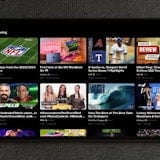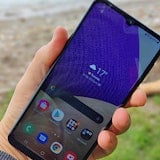
Everyone is talking about wearable technology. From Google Glass to the fabled Apple iWatch, it seems we can’t wait to attach SMS notifications to ourselves. But is this all wearable tech has to offer? We hope not.
The Galaxy Gear has been met with a barrage of negative reviews, with criticisms ranging from poor battery life, to discomfort, to limited functionality. We have to say that we unfortunately agree with a lot of these points, but not necessarily all.
Design
3/5
The Gear is pretty big for a wristwatch. Its large watchface is flat-edged across the back, meaning that it can press in to the bone, depending on the shape of your wrist. We found that it caused discomfort verging on dull pain when worn for a whole day.
The tightness of the wriststrap is adjustable, but not enough. Some users will find that they will be stuck between uncomfortably tight and annoyingly loose. The wrist strap itself is very firm and stiff. This is probably to protect the strap-mounted camera, but it creates an unpleasant feel.

The clasp holds the Gear’s speaker, making the clasp itself is quite bulbous. It’s not noticeable normally, but the instant you sit at a computer and start typing it has the tendency to roll your hand sideways.
Ultimately we ended up just taking it off and resting it on the desk whenever we were at work. This isn’t a great result for something that’s supposed to stay attached to your person all day long.

Screen and user interface
3/5
The display is the Gear’s best feature. We’ve never seen the Gear’s level of clarity on a screen so small. Most of the time it goes unutilized by the pretty boring UI, but running video playback is outstanding. It would have handled video calls fantastically, if they were possible on the Gear.

The home screen is customisable. You can set different watch faces or choose between a combination of watch & pedometer, watch & upcoming events, watch & app shortcuts, or a two-timezone watch etc. It can even be replaced by 3rd party downloaded versions if you’re after something a bit more unique.
Beyond the home screen the interface is less elegant. Each individual screen is dedicated to only one app. This has the advantage of looking less-cluttered, but it ultimately means you’ll be swiping a whole lot more often than you have to.

However, the applications menu displays four icons per screen; a much better solution. The frustrating thing here is that many of the icons are repeats of the single-icon screens in the menu layer above. Samsung could easily have opted for a four-icon layout by default and saved us all a lot of finger-work.
Battery life isn’t great. Power tends to last almost two days, meaning it needs charging every night. This is more hassle than we’d want from a device that’s supposed to streamline our tech experience and make everything simpler.
Samsung has employed a screen timeout trick to save on battery. The Gear’s screen is designed to turn off when it’s aimed away from you and turn back on when tilted towards your face. It’s a good idea, but what ends up happening is that the screen turns on and off almost at random, distracting you and drawing your eye throughout the day.
It’s not too much of a hassle in most situations, but when you’re driving a car it activates almost every time you turn a corner and draws your eyes from the road where they should be.
You can disable this feature, but that means you’ll have to press the home button every time you want to check the time or check notifications. This turns the Gear in to a device that requires two hands. It’s hardly optimum.
Notifications
3/5
Hands-down the best part about any smartwatch is receiving notifications on your wrist. The Gear handles this well by vibrating and, if you have it set, playing a notification sound whenever an SMS or call is being received.
With messages, the name of the sender appears and stays on screen for a few seconds, giving you time to tap on the screen to bring it up. To reply, you can either dictate the message with voice input or pull your phone out and reply manually.

We found that even if you opt for the second option this cuts down noticeably on how much time you spend staring at your phone. We started to formulate a response to the message while we were pulling our phone from our pocket, giving us a head-start in typing up the message. You’re much less likely to end up being that idiot who walks in to a car because you were glued to your phone’s screen.
Receiving a call is on the Gear is really just an alternative to answering on your phone and putting it on speaker. You talk in to the watch face and receive sound out the back speaker. The mic quality is surprisingly clear, but the speaker is quite poor. It’s difficult to make out sounds in moderately loud environments, like a bus or a train.

Unfortunately, you can’t get other alerts like Facebook or even Email notifications on the Gear. That ability may come with future apps, but unless the Gear proves to be a runaway success (and it’s not looking good) this could be unlikely.
Camera
2/5
The wrist-strap camera is about as good as the average front-facing camera on a smartphone, so it’d be great for video calls but not really anything else. Unfortunately it’s located on the strap facing away from the user, making video calls impossible.

You could use it to take a ‘candid’ snapshot or two, but the shutter noise makes even that difficult. The noise can be disabled in some regions, but in ours the Gear was unfixably one of the loudest camera’s we’ve used on a gadget.
This pretty much relegates the Gear to taking sneaky photos in loud locations like bars or a night club, and seriously, that’s just creepy.
We would have loved to see a front-facing camera in the head unit itself. One handy use of this would be a sort of always-handy mirror for fixing hair or make-up in a pinch.
Mostly we’d want it for video calls – not for the functionality but because video-phone-watches were pretty much synonymous with “the future” when we, the Gear’s target demographic, were growing up and watching spy movies. Video call support would have allowed the Galaxy Gear’s fantastic screen to really come in to its own in a way our 5 year-old selves could only ever have imagined.
Verdict
3/5
The Galaxy Gear does function as a smartwatch, but its attempts to do more without actually doing anything new end up delivering a bulky device with limited use. Checking SMS and calls as they come in is far more useful than we’d have expected, but it doesn’t make up for the discomfort of wearing something so large and stiff around all day.
Add to that the short battery life and a limiting price-tag and we don’t imagine the Galaxy Gear will appeal to too many users.
Sorry Samsung, maybe next time.
Related Articles
Find Better Phones and Plans
Hundreds of cell phone plans unpacked. All the facts. No surprises.








































